

Understanding Agentic AI and How It Drives Business Growth






We’re all familiar with AI tools that can write an email, summarize a report, or even generate code. But once it’s done, it freezes. No next step, no follow-through. It just waits for your following prompt. That’s how most generative AI works; it’s responsive, not proactive.
Generative AI models are excellent at creating text, images, or audio, but they don’t plan or act on their own. They generate the result and then wait for your next move.
Agentic AI changes this approach. It doesn’t just wait for instructions; it takes goals, breaks them into smaller steps, executes them, and adapts along the way. Instead of being passive assistants, agentic systems can actively work toward an outcome.
In this blog, we’ll explore what Agentic AI is, how it functions, its top use cases, key benefits and risks, and how it’s shaping the next evolution beyond generative AI.
Agentic AI refers to systems that can act autonomously to achieve a goal. Unlike traditional AI models that wait for a prompt, agentic AI takes an objective, makes a plan, and executes it with little to no human input. It can make decisions, use tools, and adjust its actions based on what works and what doesn't.
In simple terms, Agentic AI behaves like a digital helper that can take the lead. It doesn’t just create results; it also determines what needs to be done and how to accomplish it. The aim isn’t to replicate how people think, but to complete tasks that require multiple steps and small decisions while following clear rules.
Agentic AI systems can:
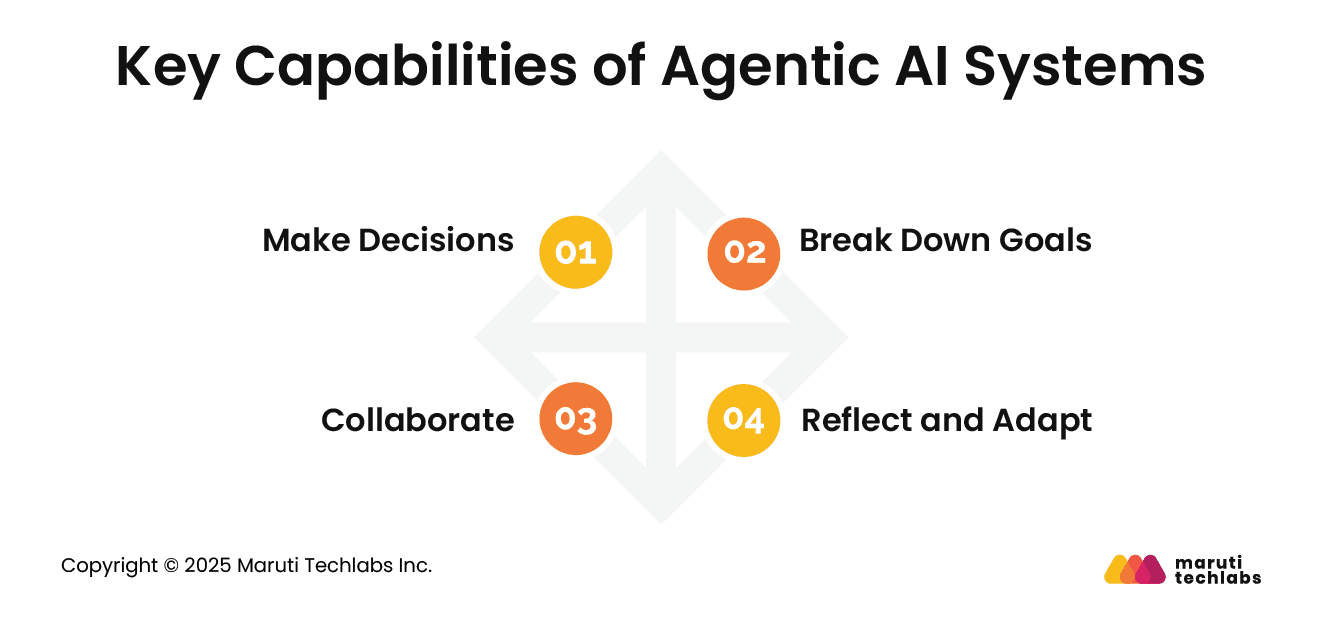
Behind the scenes, several components make this possible: a goal interpreter to understand objectives, a planner to organize tasks, access to tools for execution, and memory to track progress. A feedback loop helps them evaluate results and adapt as needed.
This ability to think ahead, take action, and self-correct is what makes Agentic AI an important step forward beyond generative AI.
Agentic AI is built on large language models (LLMs), but it operates more intelligently. Traditional LLMs simply generate answers based on the data they were trained on.
In contrast, agentic systems can use tools, APIs, and real-time information to achieve complex goals. They can gather new data, create smaller tasks, and streamline workflows without waiting for instructions.
Another key strength of Agentic AI is its natural ability to interact with people. You can communicate with it in plain language, and it understands context just like a human teammate would. What truly sets it apart is its memory. Instead of starting fresh every time, Agentic AI remembers past interactions, learns from them, and improves its accuracy over time.
Agentic AI works best when multiple agents operate together as a network, each handling different tasks and levels of complexity.
Here are the major types of agentic systems:
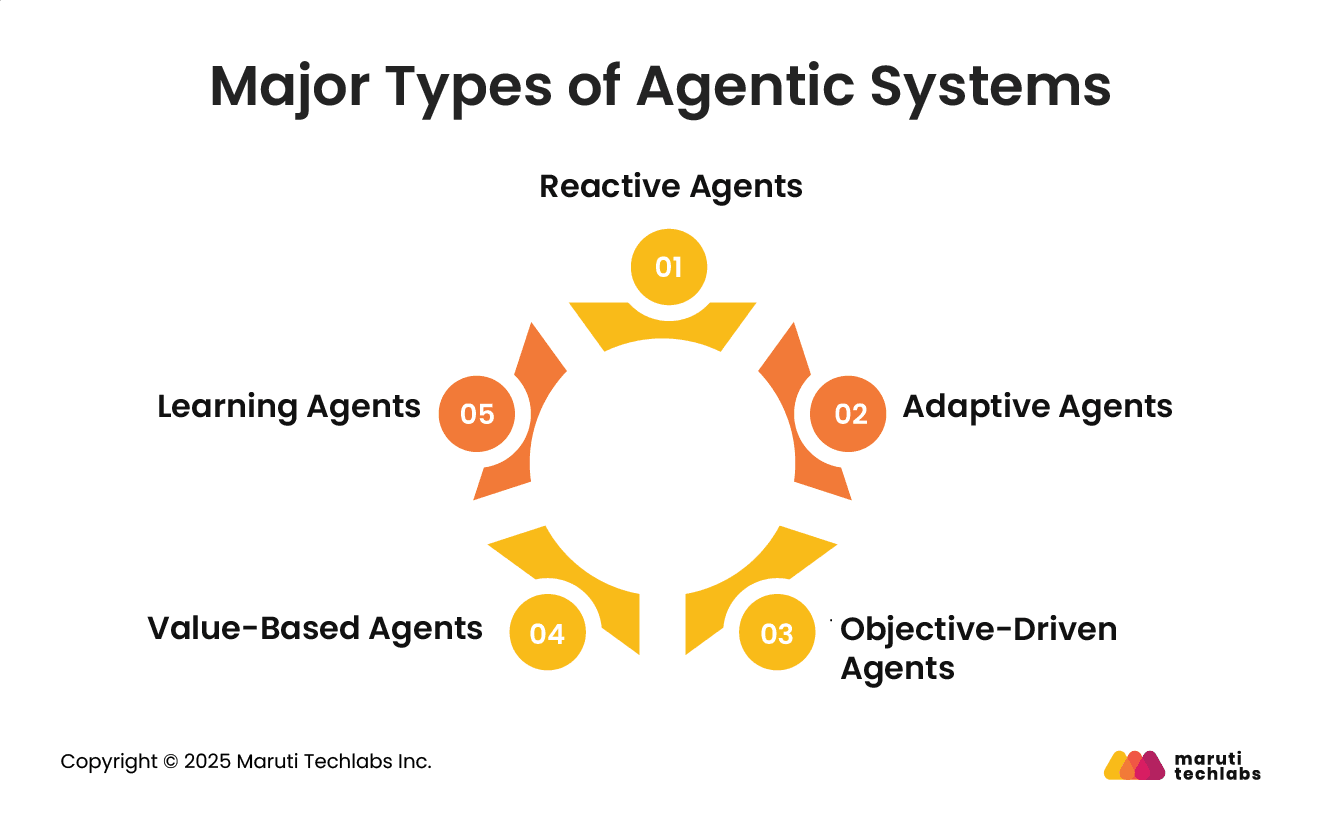
Together, these agents form the backbone of Agentic AI systems that don’t just respond but take action, coordinate, and get smarter with every interaction.
Agentic AI is already being utilized in various fields to streamline work and increase efficiency. Here’s how it’s helping different industries today.
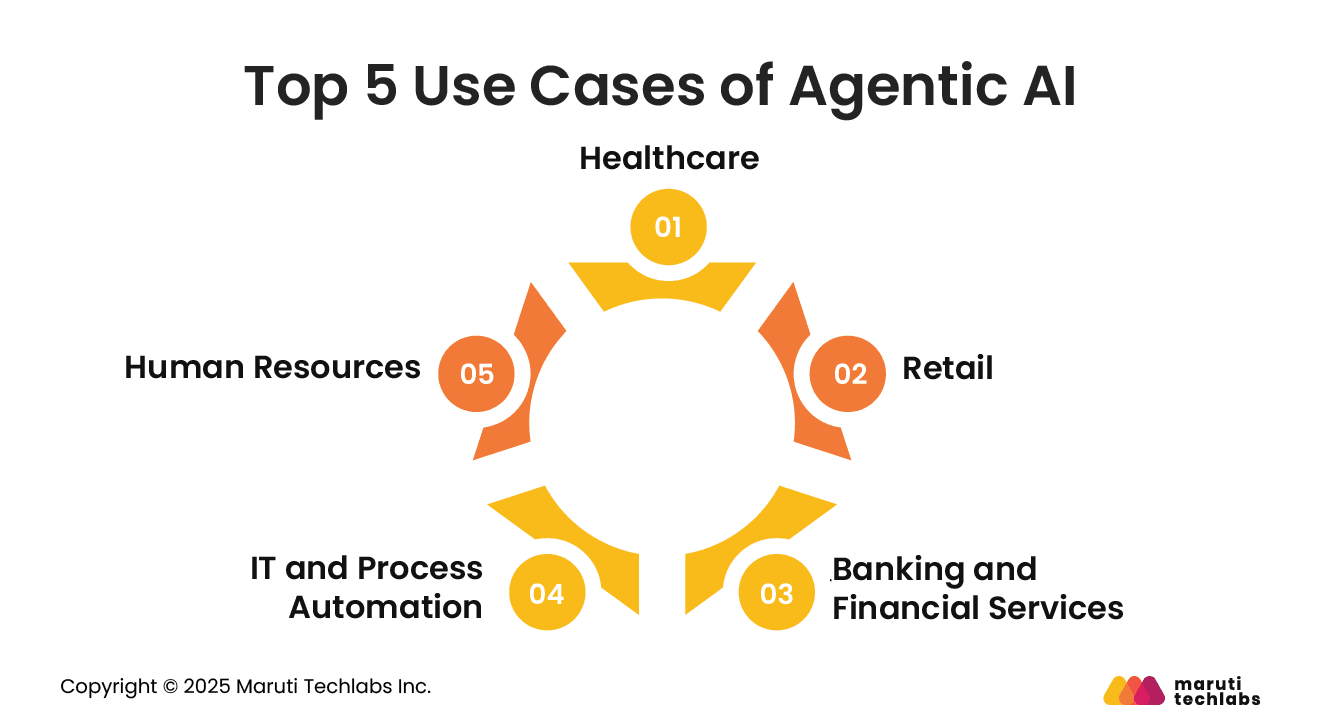
In the healthcare sector, agentic systems help reduce the daily workload for doctors and staff. They can handle billing, schedule appointments, and manage patient records. These systems can also keep an eye on patient data, spot early signs of health problems, and support doctors in making better decisions. This means faster care, fewer delays, and more time for patients.
Retail platforms use agentic systems to make shopping easier and more personal. They can suggest products, manage inventory, and adjust prices in response to changing demand. In some shops, they even check shelves to see what needs restocking. This helps retailers avoid shortages, reduce waste, and offer customers a smoother shopping experience.
In finance, these systems help track transactions, detect risks, and make sure all processes follow rules and regulations. They also assist customers by creating simple investment plans and managing regular tasks, such as monitoring accounts. This saves time and helps banks work more safely and efficiently.
In IT, agentic tools help keep systems running without interruption. They can identify and resolve issues before they escalate into larger problems. Developers also use them to test code or improve system performance, which makes technical teams more productive.
In HR, agentic systems handle routine tasks such as sorting resumes, scheduling interviews, and addressing employee inquiries. They can even suggest training plans for staff based on their roles. This allows HR teams to focus on people instead of paperwork.
Agentic AI can make decisions and take action on its own, which helps people and businesses work faster and smarter. But it also brings a few challenges that need careful handling.
The key ways agentic AI enhances the daily operations of organizations and individuals are outlined below.
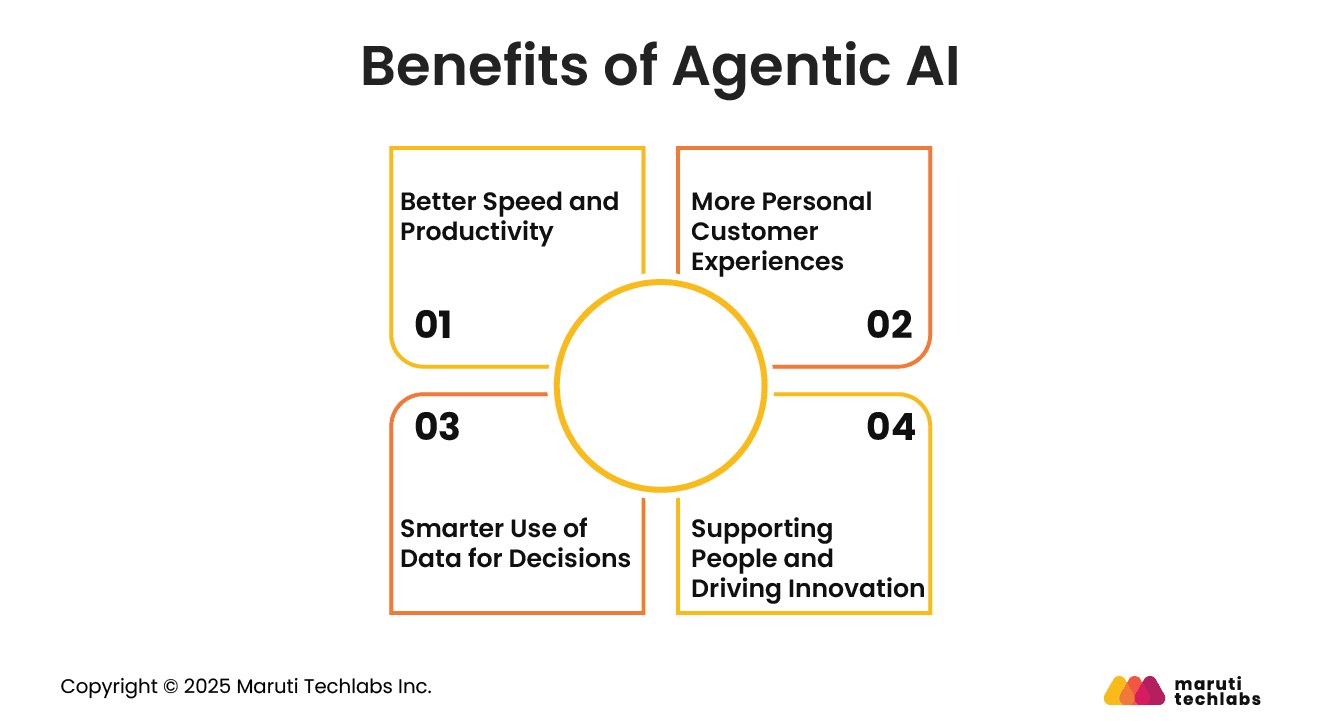
Agentic AI helps teams accomplish more by automating the detailed, repetitive tasks that typically slow everyone down. It continues to work without requiring constant instructions, allowing things to move faster with fewer delays. This means fewer bottlenecks in areas such as customer support, data processing, and daily operations, allowing people more time to focus on creative or strategic work.
Agentic systems can understand customer needs and tailor responses in real time. For example, a support assistant can identify what a customer is looking for and provide a suitable answer or recommendation right away. This leads to quicker, more helpful interactions and happier customers who feel understood and valued.
Agentic AI can quickly analyze large amounts of data and identify useful patterns. This helps businesses make informed choices, such as adjusting supply chains or spotting risks early. Because it works with current data, decisions are more accurate and timely, enabling companies to act faster and stay ahead.
Agentic systems don’t replace humans; they work alongside them. While the system manages routine or data-heavy work, people can focus on planning, creating, and solving problems. This blend of human insight and AI efficiency yields new ideas, enhanced workflows, and more innovative ways of working.
While the benefits are clear, it’s equally important to understand the challenges that come with using agentic AI.
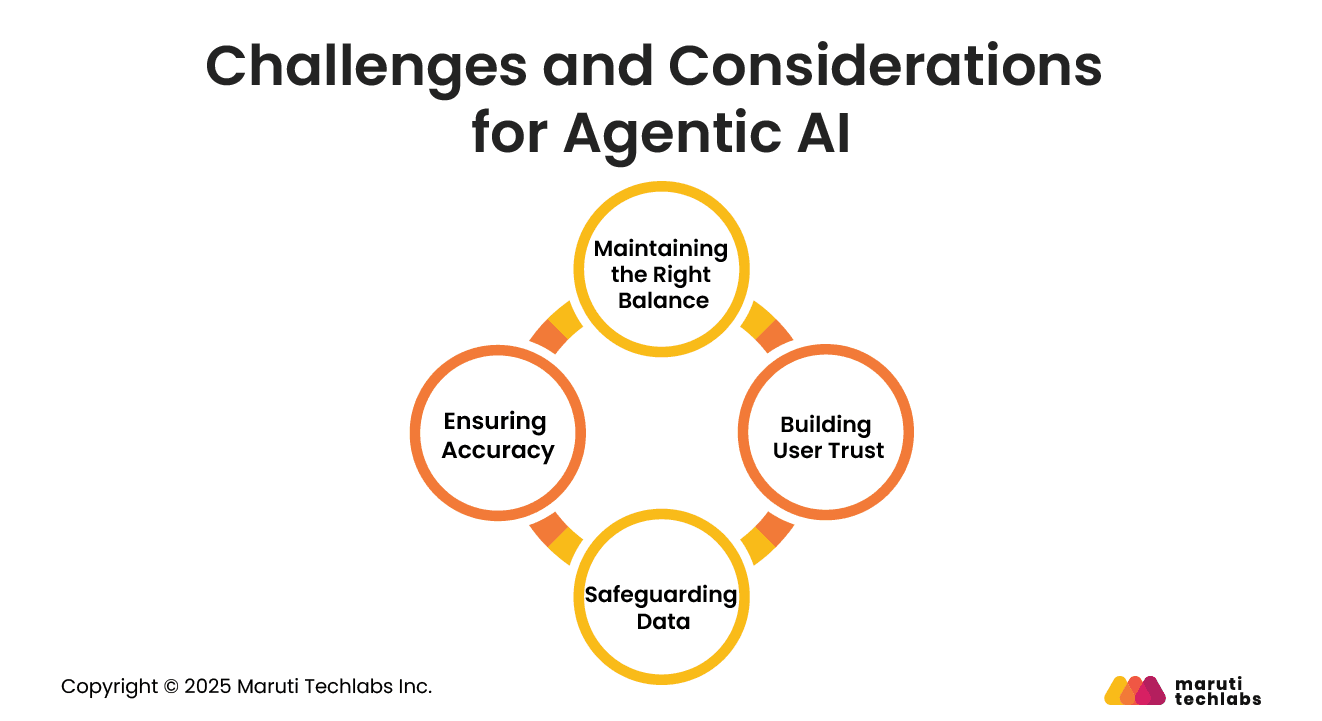
While it’s helpful to let systems make their own decisions, some human supervision is still necessary. People should step in for essential or sensitive tasks to avoid wrong choices.
Sometimes, it may not be clear why the system made a certain choice. To build trust, organizations should be transparent about their processes and capabilities.
These systems often handle private or essential information, and keeping data safe is key. Strong passwords, secure systems, and regular checks help prevent leaks or misuse.
Even smart systems can make errors or misunderstand information. It’s important to review their work, fix mistakes quickly, and make sure someone is responsible for oversight.
When used carefully, agentic AI can make everyday work easier and more effective. The key is to stay involved, set clear rules, and maintain safety and transparency at every step.
Agentic AI is changing how businesses use technology. In the past, AI systems relied on people to provide them with instructions. Now, they can understand goals, make informed decisions, and complete tasks independently. This change is similar to how software grew from simple tools to full applications that could handle more on their own.
Soon, we may no longer think of “using AI” as simply typing commands or prompts. Instead, we’ll work with smart agents that manage tasks for us. Many modern tools already have this built-in intelligence. They can understand what needs to be done, keep track of progress, and update us once the job is finished.
Workflows will also become more agent-led as these systems automate repetitive tasks, such as checking data, organizing files, or preparing reports. This allows people to focus on creative, strategic, or customer-facing work.
Over time, every team could have its own set of agents assisting in areas such as IT, HR, or customer support. Companies that utilize these systems thoughtfully will experience smoother operations, quicker decision-making, and stronger collaboration across teams.
Agentic AI represents a quiet yet significant step in how businesses utilize technology. When applied thoughtfully, it helps people work smarter, not harder. These systems can perform repeatable, multi-step tasks, make decisions, and work alongside humans with minimal guidance. The result is smoother workflows, faster results, and more time for teams to focus on meaningful work.
There is still more to understand about guiding these systems, ensuring their reliability, and preparing teams to use them effectively. However, the shift toward goal-driven AI has already begun. Organizations that adopt it early will benefit from higher efficiency, improved decision-making, and stronger collaboration between people and intelligent systems.
At Maruti Techlabs, we help organizations explore and implement GenAI solutions built for real-world impact. Learn more about our GenAI services or contact us to discuss how Agentic AI can support your goals.
Traditional AI follows instructions and responds to prompts, whereas agentic AI can take action independently. It understands goals, plans the steps to achieve them, and adapts as needed without requiring constant human input.
Agentic AI can manage IT systems, automate customer support, handle financial audits, or assist doctors with diagnosis. For instance, it can monitor data, detect issues, and take corrective steps automatically, helping teams save time and work more efficiently.
Agentic AI takes a goal from the user, breaks it into smaller tasks, and completes them using data, tools, and feedback. It learns from results and improves its performance over time, allowing it to operate more independently and make smarter decisions.


